Bill Kluge
Reviews By Author
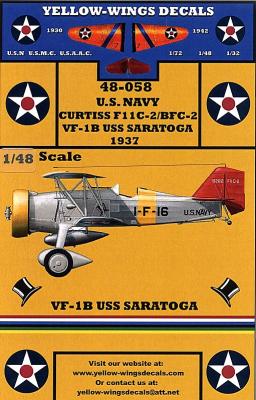
|
New Curtiss F11C-2/BFC Goshawk VF-1B - UPDATED -Published:
This set provides decals for four Curtiss Goshawk section leader’s aircraft, and includes a few surprises in the way of markings that are pretty rare for the Goshawk. The aircraft covered include:
The first surprise was the inclusion of markings for Enterprise based BFC-2s. I was unaware that the Big E ever carried… more |

|
RAF Harrier Ground Attack - FalklandsPublished:
Prior to this book, very little had been written in detail describing the RAF Harrier GR3 operations during the 1982 Falklands War. This book fills that void very well, providing a wealth of detail in describing the lead up, deployment and day-to-day combat operations of the small contingent of Royal Air Force attack Harriers. It makes a fitting companion to Sharkey Ward’s earlier narrative Sea Harrier over the Falklands. As one of the senior officers of No.1(F) squadron, the author describes the scramble to prepare for deployment to the South Atlantic at a time when the RAF in particular, and the nation’s armed forces in general were facing severe austerity measures. He also provides some interesting insight into the plight of “non naval persons” trying to adapt to… more |
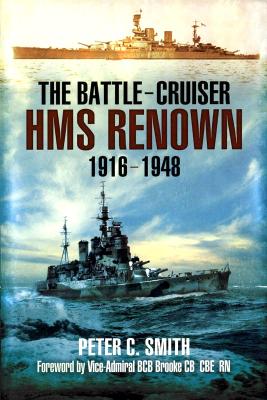
|
The Battle-Cruiser HMS Renown 1916 - 1948Published:
“Speed is Armor” Such was the concept behind the brainchild of Royal Navy Admiral Sir John Fisher. When he became First Sea Lord in 1904, he began to turn his many innovative concepts of naval warfare and warship design into reality. One of these was of a new breed of warship – heavily armed yet lightly armored but faster than her enemies. In theory, what she couldn’t out fight, she could out sail. And so the soon to be called “battle cruiser” was born, the last of these built for the Royal Navy was HMS Renown. Although armed with six 15-inch guns, she was never intended to form a part of the capital ship battle line. Yet, their heavy armament and promotion as very powerful units often compelled commanders to use battlecruisers in roles they were unprepared for. While they… more |
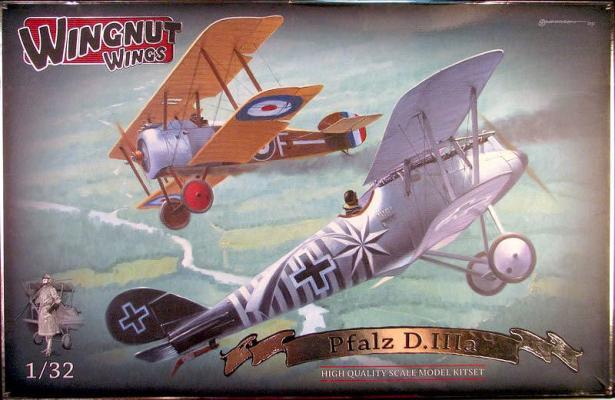
|
Pfalz D.IIIaPublished:
1918. A conversation overheard in a Jasta commander’s office as he questions a replacement pilot: What did you train on? That was my introduction to the Pfalz fighter back in 1966, compliments of The Blue Max (even if they were replicas and reconfigured Tiger Moths). Pfalz’s most successful fighter was its first original design, the D.III (and D.IIIa, a minor modification bringing the aircraft’s two machine guns outside the fuselage to… more |
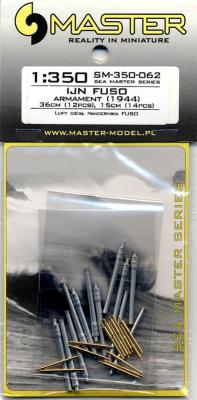
|
IJN Fuso Armament 1944Published:
Master from Poland has added to their impressive line of Sea Master Series detailed ship gun barrels with this set of main and secondary guns for the Fujimi battleship Fuso. Included in this set are twelve 14” (360 mm) turned stainless steel barrels, and fourteen 6” (150mm) turned brass barrels. Both the brass and steel barrels are precisely tapered, with petite segmentations along the barrel length and at the ends. Each of the barrels has an ever so slightly flared open end. I don’t have the Fujimi Fuso, but there’s no reason to believe that these parts could not be used with either the Fujimi Fuso or Kongo class battleships. Both vessels carried 14”/45 main guns (12 in Fuso and Yamashiro, and 8 in the Kongos). In a comparison with… more |
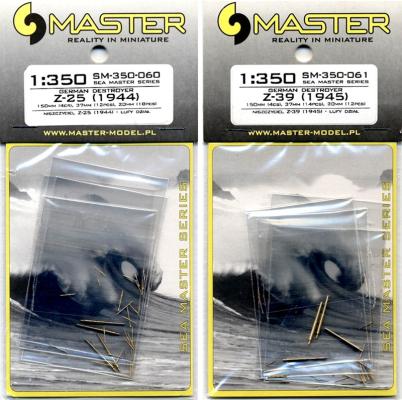
|
German Destroyer Barrels, Z-25 (1944) and Z-39 (1945Published:
These two armament sets from Master Model provide a full range of replacement brass gun barrels for the new Dragon German Destroyer kits. Set contents include:
Each of the brass barrels is slightly tapered with very finely defined segmentations. Additionally, all of the 20mm barrels and some of the 37mm barrels in each set (four for the Z-25 and ten for Z-39) have barely discernable (but yet, in scale) flash suppressors at the open ends of the barrels. The very high level of manufacturing craftsmanship is readily visible in all the Master Model products, and these sets are certainly no exception. My thanks to Master Model for providing… more |
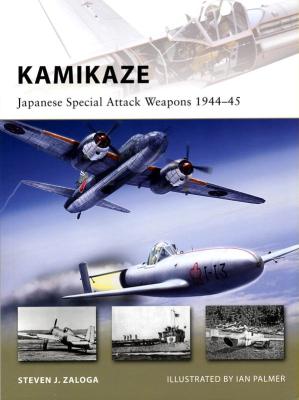
|
Kamikaze: Japanese Special Attack Weapons 1944-1945Published:
Any student of the Pacific War will be familiar with Japan’s use of thousands of conventional aircraft – fighters, bombers, trainers and nearly every other type flown by her Army and Naval Air Forces – into “Special Attack” weapons: the Kamikazes. What is less understood is Japan’s development and use of purposely designed suicide weapons. Author Steven Zaloga is well known for his extensive writing on the subject of military fighting vehicles. In this Osprey New Vanguard edition, he as done a superb job of highlighting all the various types of air, sea and land weapons used by the Japanese Army and Navy “Tokko” (special attack) units. The opening pages set up the circumstances following the U.S. invasions of the Marianas and Philippine Islands that brought about the… more |

|
USS Independence CVL-22, Smart KitPublished:
The ShipThey say Necessity is the mother of Invention. Such was the case with the Independence class of light aircraft carriers. The U.S. Navy’s pressing need for fleet carrier decks during the early stages of the Pacific War brought these vessels into being. The nine Independence class carriers were converted from Cleveland class light cruisers already under construction. Having already built a 1/700 U.S.S. Independence, I chose to build this model as one of her sisters. U.S.S. Belleau Wood was converted from U.S.S. New Haven, and commissioned as CVL-24 in March 1943, joining the U.S. Pacific Fleet four months later. She participated in numerous actions, including the invasions of the Gilbert Islands (Tarawa), Marshall Islands (Kwajalein… more |
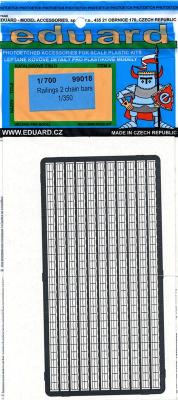
|
Railings 2 Chain BarsPublished:
This photo etch ship railing set is similar to their 3-Bar Chain railing set, with the obvious difference of having two chain levels instead of three. The accompanying photo compares the two Eduard sets, side by side.This similarity will enable me to liberally borrow from my earlier review: This unpainted stainless steel set represents drooping chain railings founds on the main decks on most all types of vessels (metal bar railings tend to be found more often on the upper superstructure deck levels). This is generic railing, not geared to any specific navy or class of ship. By way of comparison, the PE is similar in thickness to Tamiya’s, and just slightly heavier than what you get from Hasegawa, Lion Roar or Gold Medal Models. The rails are slightly… more |

|
3-Chain Bars RailingsPublished:
Adding to its expanding line of ship detail sets, Eduard has released photoetch ship railings in the popular ship modeling scales. This unpainted stainless steel set represents drooping chain railings founds on the main decks on most all types of vessels (metal bar railings tend to be found more often on the upper superstructure deck levels). This is generic railing, not geared to any specific navy or class of ship. By way of comparison, the PE is similar in thickness to Tamiya’s, and just slightly heavier than what you get from Hasegawa, Lion Roar or Gold Medal Models. The rails are slightly taller than the others mentioned, and the “chain” portion is not represented as delicately segmented chain links (like GMM’s) but as solid, drooping lines (the accompanying photo compares… more |
